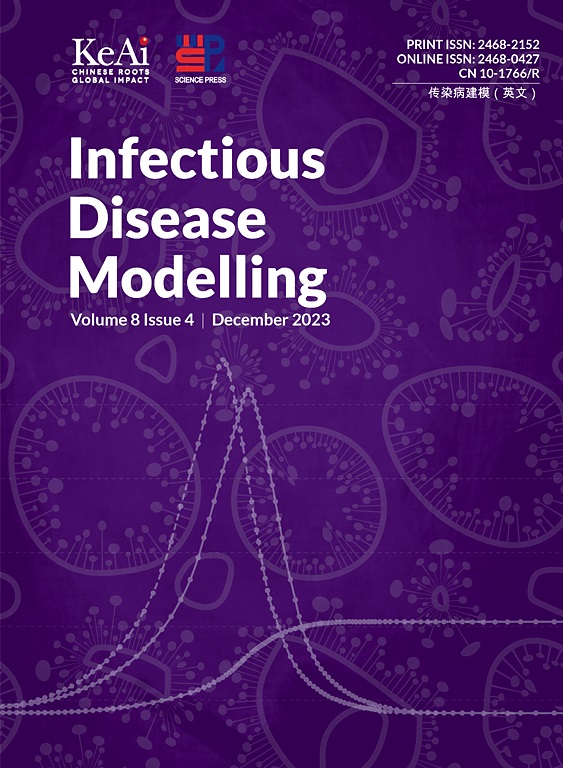Mathematical insights into mumps transmission control with optimal strategies
IF 2.5
3区 医学
Q1 Medicine
引用次数: 0
Abstract
In this study, we develop an optimal control framework for managing mumps infections through a dynamic model that integrates public health interventions such as awareness programs, isolation protocols, and a two-dose immunization regimen. We begin by establishing the model's fundamental analytical properties, including the existence and stability of disease equilibria, the positivity and boundedness of solutions, and a threshold condition for disease transmission. Local stability analysis is conducted via the Routh-Hurwitz criteria, ensuring robust insights into the disease dynamics. The optimal control problem is formulated and analyzed using Pontryagin's Maximum Principle, which facilitates the derivation of optimal interventions. Numerical simulations are conducted to assess various control strategies and compare the effectiveness of single and combined interventions. Our results indicate that a balanced solution is key to effective disease mitigation. A comprehensive approach employing all four controls: awareness, isolation, primary and booster vaccination, is the most effective strategy. Moreover, strategies that incorporate vaccination consistently outperform those without. Interestingly, a three-control strategy closely approximates the effectiveness of the full four-control intervention, suggesting a cost-effective alternative for practical implementation. While the four-control strategy may incur higher implementation costs, the three-control strategy offers a balanced solution, achieving substantial disease reduction while optimizing resource allocation. Our findings underscore the crucial role of vaccination in mumps control. They offer valuable insights for policymakers, emphasizing the need to balance economic considerations with public health outcomes. Vaccination, as our study demonstrates, is a cornerstone of any effective mumps control strategy.
用最佳策略控制腮腺炎传播的数学见解
在这项研究中,我们通过一个动态模型开发了一个管理腮腺炎感染的最佳控制框架,该模型整合了公共卫生干预措施,如意识规划、隔离方案和两剂免疫方案。我们首先建立了模型的基本分析性质,包括疾病平衡点的存在性和稳定性,解的正性和有界性,以及疾病传播的阈值条件。通过劳斯-赫维茨标准进行局部稳定性分析,确保对疾病动态的有力洞察。利用庞特里亚金极大值原理对最优控制问题进行了表述和分析,从而方便了最优干预的推导。进行了数值模拟,以评估各种控制策略,并比较单一和联合干预的有效性。我们的研究结果表明,平衡的解决方案是有效缓解疾病的关键。采用所有四种控制措施:认识、隔离、初次和加强疫苗接种的综合办法是最有效的战略。此外,纳入疫苗接种的战略一贯优于不纳入疫苗接种的战略。有趣的是,三控策略非常接近四控干预的有效性,这为实际实施提供了一种具有成本效益的替代方案。虽然四控战略可能带来更高的实施成本,但三控战略提供了一种平衡的解决方案,在优化资源配置的同时实现了大幅减少疾病。我们的发现强调了疫苗接种在腮腺炎控制中的关键作用。它们为政策制定者提供了宝贵的见解,强调了平衡经济考虑与公共卫生结果的必要性。正如我们的研究所表明的那样,疫苗接种是任何有效的腮腺炎控制战略的基石。
本文章由计算机程序翻译,如有差异,请以英文原文为准。
求助全文
约1分钟内获得全文
求助全文
来源期刊

Infectious Disease Modelling
Mathematics-Applied Mathematics
CiteScore
17.00
自引率
3.40%
发文量
73
审稿时长
17 weeks
期刊介绍:
Infectious Disease Modelling is an open access journal that undergoes peer-review. Its main objective is to facilitate research that combines mathematical modelling, retrieval and analysis of infection disease data, and public health decision support. The journal actively encourages original research that improves this interface, as well as review articles that highlight innovative methodologies relevant to data collection, informatics, and policy making in the field of public health.
 求助内容:
求助内容: 应助结果提醒方式:
应助结果提醒方式:


